SHAWLS WRAPS AND SCARVES 
 Copyright Copyright 2020 by Louisa Harding All rights reserved. Design & Editorial Louisa Harding Photography & Design Layout Stephen Jessup Bibliographical NoteShawls, Wraps, and Scarves: 21 Elegant and Graceful Hand-Knit Patterns is a new work, first published by Dover Publications, Inc. in 2020. Library of Congress Cataloging-in-Publication Data Names: Harding, Louisa, author. Title: Shawls, wraps, & scarves Louisa Harding. | Includes bibliographical references and index. | Summary: Whether you are looking for a classic shawl, chic evening wrap, or simple scarf pattern, this pattern book by Louisa Harding, one of the worlds most influential designers, will inspire you to create beautiful hand-knitted garments. | Summary: Whether you are looking for a classic shawl, chic evening wrap, or simple scarf pattern, this pattern book by Louisa Harding, one of the worlds most influential designers, will inspire you to create beautiful hand-knitted garments.
Copyright Copyright 2020 by Louisa Harding All rights reserved. Design & Editorial Louisa Harding Photography & Design Layout Stephen Jessup Bibliographical NoteShawls, Wraps, and Scarves: 21 Elegant and Graceful Hand-Knit Patterns is a new work, first published by Dover Publications, Inc. in 2020. Library of Congress Cataloging-in-Publication Data Names: Harding, Louisa, author. Title: Shawls, wraps, & scarves Louisa Harding. | Includes bibliographical references and index. | Summary: Whether you are looking for a classic shawl, chic evening wrap, or simple scarf pattern, this pattern book by Louisa Harding, one of the worlds most influential designers, will inspire you to create beautiful hand-knitted garments. | Summary: Whether you are looking for a classic shawl, chic evening wrap, or simple scarf pattern, this pattern book by Louisa Harding, one of the worlds most influential designers, will inspire you to create beautiful hand-knitted garments.
Knitters of all skill levels will value the simple and delicate stitch patterns, which result in surprisingly sophisticated styles. More advanced knitters will appreciate the projects that introduce more complicated techniques involving lace, cable, and beading Provided by publisher. Identifiers: LCCN 2019037898 | ISBN 9780486839998 (trade paperback) Subjects: LCSH: KnittingPatterns. | Shawls. | Scarves. Classification: LCC TT825 .H3825 2020 | DDC 746.43/2041dc23 LC record available at https://lccn.loc.gov/2019037898 Manufactured in the United States by LSC Communications 83999001 www.doverpublications.com 2 4 6 8 10 9 7 5 3 1 2019 CON TENTS  INSPIRATION
INSPIRATION  INTRODUCTION SHAWLS, WRAPS, AND SCARVES In this book, the hand-knit projects are categorized into three sections: shawls, which are triangular in shape, rectangular knitted wraps, and oblong-shaped scarves of varying lengths and construction.
INTRODUCTION SHAWLS, WRAPS, AND SCARVES In this book, the hand-knit projects are categorized into three sections: shawls, which are triangular in shape, rectangular knitted wraps, and oblong-shaped scarves of varying lengths and construction.
Traditionally, these items of clothing are knitted and worn to provide warmth. However, for the hand-knit designer, they provide the ideal design canvas. With the canvas established, which element comes first with a hand-knit design? The shape?The ya n? The c eative idea? As a design student, you are taught that every project starts with visual research work. Having been trained in this way I am constantly absorbing images, originally captured in note form in a sketchbook that traveled everywhere with me, and more frequently now as photographs on my phone. Often when sketching out design ideas, I am amazed to see what has inspired me. As an introduction to each project, I detail an element of my design process.
For Larks Alvina, shape was my starting point. I wanted to create a triangular shawl that had a repetitive stitch pattern, easy to memorize, but when tied around the neck I wanted it to lie flat So I constructed a pointed edging, like a clipped curve in dressmaking. This allows the shawl to lie flat Ginerva wrap combines two design elements: yarn and creative inspiration. I found a stunning plant-dyed kid silk mohair and wanted to combine it with a lace weight cashmere. The colors are similar, but the kid silk mohair behaves in a different way when knitted: light and flyaw y. Looking back at photographs I had taken while on a spring walk, I came across an image of unfurling bracken, which appeared as opening hearts.
I looked for a stitch pattern that represented this image and would work well with both yarns to create an ethereal design. The creative inspiration for Raizel was to design my own interpretation of the Paisley shawl. I had the idea for the motif shape using the Fair Isle knitting technique. When I originally swatched the design, I realized I wanted the hem to echo the bottom of the paisley outline. So I reswatched the design using a feather and fan stitch edging, which gave me the undulating hem. Thecolors I had originally selected did not provide enough contrast and again I looked to my visual resource images to find the ideal oatmeal and charcoal combination.
My aim for this collection of patterns was to have a balance of projects: some stitch patterns simple to memorize and other designs more challenging and involved. One of the highlights of knitting a shawl, wrap, or scarf is unlike knitting a garment that needs to be fitted together like a jigsaw, you can combine yarn types and contrast stitches. The photographed projects have been designed to use specific yarns and colors. However, the knitting gauge is less of a constraint and is the perfect opportunity to try out unusual or precious yarns. I do hope you find patterns to inspire you on your creative knitting journey.  SHAWLS WRAPS AND SCARVES
SHAWLS WRAPS AND SCARVES  SHAWLS
SHAWLS 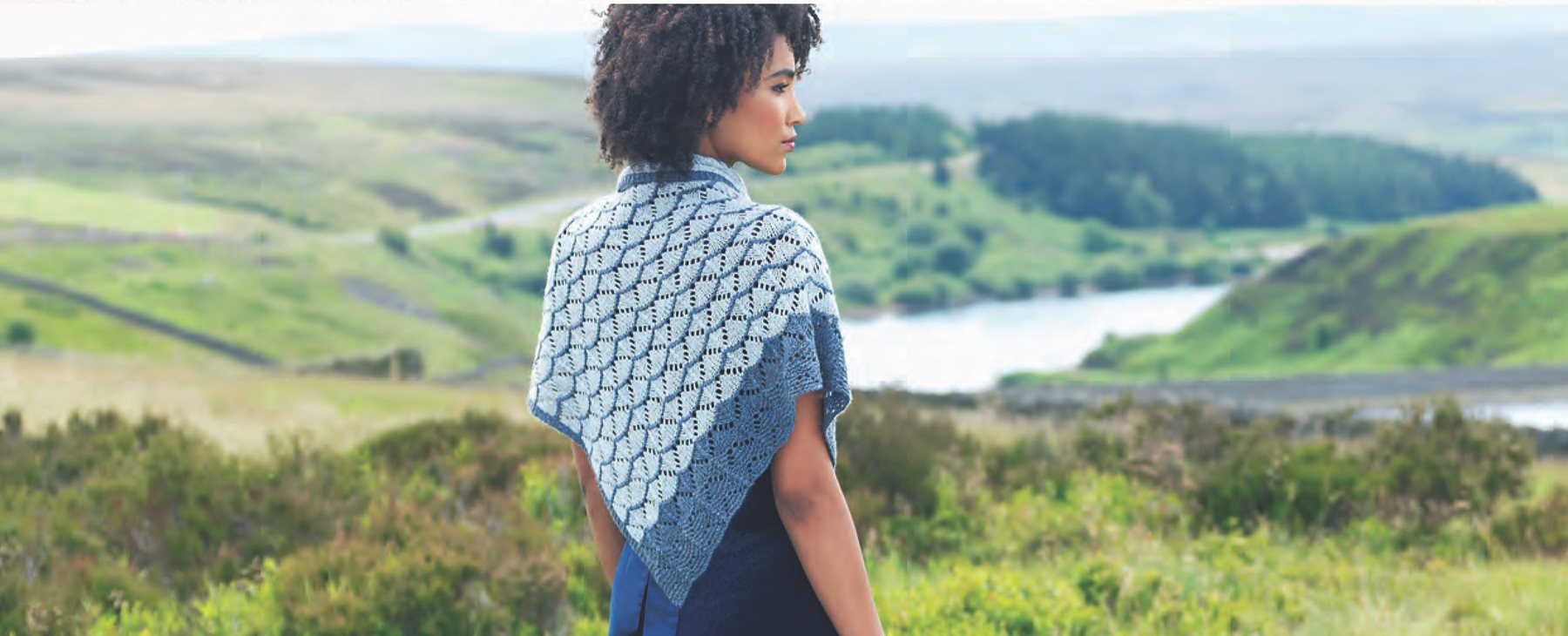
 SHAWLS
SHAWLS 
 MIRA FLUTTERING LACE EDGE SHAWL An elegant triangular shawl knit in lace weight yarn is the perfect addition to any wardrobe.Inspired by Victorian pocket handkerchiefs with delicate crochet details, this pretty lace edging undulates at the shawls hem and flutters as it catches the breeze.SHAWL Triangular shawl knitted from the bottom up Wet blocking dimensions Approximate length at center: 20 inches (51 cm) Approximate wingspan: 44 inches (112 cm) YARN Knitted in lace weight yarn Approximately 464 yards (425 m) Photographed in Yarntelier Cashmere Lace 1 x 50g ball color 108 Fireside NEEDLES & NOTIONS US 6 (4 mm) 24 inches (60 cm) circular knitting needle 12 stitch markers GAUGE 20 stitches x 26 rows to 4 inches (10 cm) square measured over stockinette stitch, once washed and wet blocked NOTE Because of the large number of stitches cast on, I suggest using a circular needle.
MIRA FLUTTERING LACE EDGE SHAWL An elegant triangular shawl knit in lace weight yarn is the perfect addition to any wardrobe.Inspired by Victorian pocket handkerchiefs with delicate crochet details, this pretty lace edging undulates at the shawls hem and flutters as it catches the breeze.SHAWL Triangular shawl knitted from the bottom up Wet blocking dimensions Approximate length at center: 20 inches (51 cm) Approximate wingspan: 44 inches (112 cm) YARN Knitted in lace weight yarn Approximately 464 yards (425 m) Photographed in Yarntelier Cashmere Lace 1 x 50g ball color 108 Fireside NEEDLES & NOTIONS US 6 (4 mm) 24 inches (60 cm) circular knitting needle 12 stitch markers GAUGE 20 stitches x 26 rows to 4 inches (10 cm) square measured over stockinette stitch, once washed and wet blocked NOTE Because of the large number of stitches cast on, I suggest using a circular needle.
Place a marker every 20 stitches cast on. This helps to keep count of the stit hes. Remove the stitch markers on the first ow. MIRA SHAWL Using US 6 (4 mm) circular needle, work picot cast on as folls: *Cast on 7 sts using the cable cast-on method, bind off 2 sts slip st on RH needle back on to LH needle* (5 sts now on LH needle), rep from * to * until there are 290 sts on needle, cast on 3 sts. (293 sts) Work 2 rows in garter st. Next row: K3, (SSM, K26) 11 times, SSM, K3. Next row: K3, (SSM, K26) 11 times, SSM, K3.
Work 8 rows lace patt from written instructions as folls: Row 1 (RS): K4, SSM, (K6, K3tog, (yo, K1) twice, yo, S2K1P2, (yo, K1) twice, yo, S1K2togP, K7,
Next page
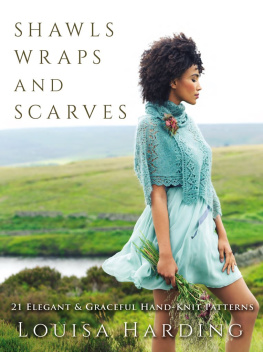

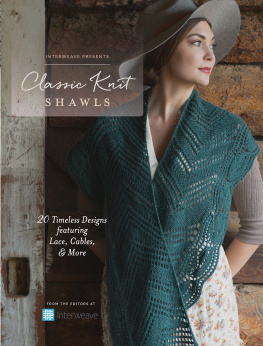
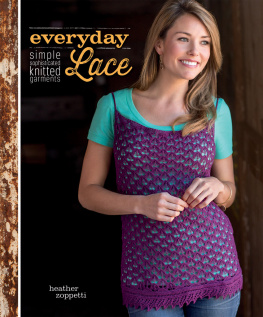

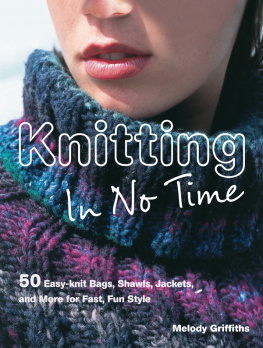


 Copyright Copyright 2020 by Louisa Harding All rights reserved. Design & Editorial Louisa Harding Photography & Design Layout Stephen Jessup Bibliographical NoteShawls, Wraps, and Scarves: 21 Elegant and Graceful Hand-Knit Patterns is a new work, first published by Dover Publications, Inc. in 2020. Library of Congress Cataloging-in-Publication Data Names: Harding, Louisa, author. Title: Shawls, wraps, & scarves Louisa Harding. | Includes bibliographical references and index. | Summary: Whether you are looking for a classic shawl, chic evening wrap, or simple scarf pattern, this pattern book by Louisa Harding, one of the worlds most influential designers, will inspire you to create beautiful hand-knitted garments. | Summary: Whether you are looking for a classic shawl, chic evening wrap, or simple scarf pattern, this pattern book by Louisa Harding, one of the worlds most influential designers, will inspire you to create beautiful hand-knitted garments.
Copyright Copyright 2020 by Louisa Harding All rights reserved. Design & Editorial Louisa Harding Photography & Design Layout Stephen Jessup Bibliographical NoteShawls, Wraps, and Scarves: 21 Elegant and Graceful Hand-Knit Patterns is a new work, first published by Dover Publications, Inc. in 2020. Library of Congress Cataloging-in-Publication Data Names: Harding, Louisa, author. Title: Shawls, wraps, & scarves Louisa Harding. | Includes bibliographical references and index. | Summary: Whether you are looking for a classic shawl, chic evening wrap, or simple scarf pattern, this pattern book by Louisa Harding, one of the worlds most influential designers, will inspire you to create beautiful hand-knitted garments. | Summary: Whether you are looking for a classic shawl, chic evening wrap, or simple scarf pattern, this pattern book by Louisa Harding, one of the worlds most influential designers, will inspire you to create beautiful hand-knitted garments. INSPIRATION
INSPIRATION  INTRODUCTION SHAWLS, WRAPS, AND SCARVES In this book, the hand-knit projects are categorized into three sections: shawls, which are triangular in shape, rectangular knitted wraps, and oblong-shaped scarves of varying lengths and construction.
INTRODUCTION SHAWLS, WRAPS, AND SCARVES In this book, the hand-knit projects are categorized into three sections: shawls, which are triangular in shape, rectangular knitted wraps, and oblong-shaped scarves of varying lengths and construction. SHAWLS WRAPS AND SCARVES
SHAWLS WRAPS AND SCARVES  SHAWLS
SHAWLS 
 SHAWLS
SHAWLS 
 MIRA FLUTTERING LACE EDGE SHAWL An elegant triangular shawl knit in lace weight yarn is the perfect addition to any wardrobe.Inspired by Victorian pocket handkerchiefs with delicate crochet details, this pretty lace edging undulates at the shawls hem and flutters as it catches the breeze.SHAWL Triangular shawl knitted from the bottom up Wet blocking dimensions Approximate length at center: 20 inches (51 cm) Approximate wingspan: 44 inches (112 cm) YARN Knitted in lace weight yarn Approximately 464 yards (425 m) Photographed in Yarntelier Cashmere Lace 1 x 50g ball color 108 Fireside NEEDLES & NOTIONS US 6 (4 mm) 24 inches (60 cm) circular knitting needle 12 stitch markers GAUGE 20 stitches x 26 rows to 4 inches (10 cm) square measured over stockinette stitch, once washed and wet blocked NOTE Because of the large number of stitches cast on, I suggest using a circular needle.
MIRA FLUTTERING LACE EDGE SHAWL An elegant triangular shawl knit in lace weight yarn is the perfect addition to any wardrobe.Inspired by Victorian pocket handkerchiefs with delicate crochet details, this pretty lace edging undulates at the shawls hem and flutters as it catches the breeze.SHAWL Triangular shawl knitted from the bottom up Wet blocking dimensions Approximate length at center: 20 inches (51 cm) Approximate wingspan: 44 inches (112 cm) YARN Knitted in lace weight yarn Approximately 464 yards (425 m) Photographed in Yarntelier Cashmere Lace 1 x 50g ball color 108 Fireside NEEDLES & NOTIONS US 6 (4 mm) 24 inches (60 cm) circular knitting needle 12 stitch markers GAUGE 20 stitches x 26 rows to 4 inches (10 cm) square measured over stockinette stitch, once washed and wet blocked NOTE Because of the large number of stitches cast on, I suggest using a circular needle.